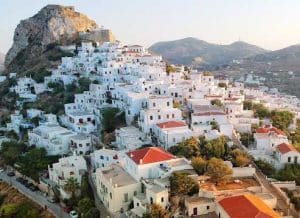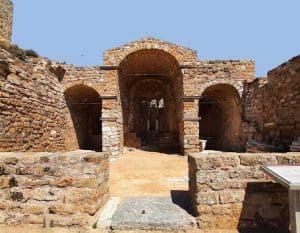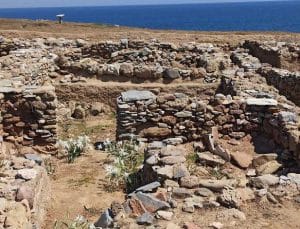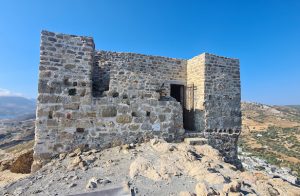What to see in Skyros
Skyros has many attractions and sights to see, traditional houses, archaeological monuments and castles and traditional art and culture.
Skyros Town has many traditional houses whose interiors are considered living museums as they are adorned with hand beaten copper pots, carved wooden furniture and elaborately decorated ceramic and embroideries. Skyros islanders take much pride in their homes and furnishings and visitors are often invited in to admire them.
The unique style of home decoration originates in the days when islanders traded prized items from marauding pirates in exchange for food. Locals started making copies of ceramics, carvings and fabrics brought to Skyros from across the Mediterranean and the tradition has been handed down over generations.
Skyros has many shops selling pottery, carved furniture and other items made locally by highly skilled craft workers.
The Chora of Skyros

You will leave the car outside Chora and take its main road, Megali Strata as the locals call it, which crosses it. But don’t just stay there.
Enter its small alleys and enjoy your walk passing houses with small courtyards full of flowers and above all be prepared to exchange smiles and good mornings with everyone you meet.
After crossing the market of Chora and reaching the end of Megali Strata, you will come across the Square of Eternal Poetry.
From this point you will enjoy a unique view down to the sea and the most beautiful sunset you have ever seen.
Visit the archaeological Museum of Skyros
Right next to the square of Eternal Poetry is the Archaeological Museum of Skyros, founded in 1963. The exhibits also include an excellent collection of ceramics, some of which were discovered in the Palamari area and others in Chora.
Also inside the museum there is a specially designed space that represents the Skyrian house as it was years ago.
Visit Faltaits Museum
The Manus and Anastasia Faltaits Museum was founded in 1964. It is one of the first Historical – Folklore Museums in Greece. Manos Faltaits once wrote that: “what I cared about was to create a ‘Museum’, i.e. a temple of the Muses and not just an exhibition of collections”. It is housed in the old mansion of Fatagidis and is worth a visit. Information about opening hours and entrance fees can be found on the museum’s website.
Walk to the Castle of Skyros

In the years when the island suffered from pirate raids, all the families had a second household inside the castle to which they went for protection.
From up there you will enjoy a unique view of the Aegean! You can go to the castle either by walking through Chora or by car to a point on the road (on the side of the cemetery) and from there you will continue on foot.
Its three sides are steep and almost vertical. Only one is passable and descends smoothly to the lowest hills on which Chora is built. The rock has been the focus of events on the island since prehistoric times and the mythological era. Here was the ancient acropolis and seat of King Lycomedes. At the “Cave of Andriotis”, the king of Athens, Theseus, was killed by Lykomedes. This is where Achilles hid disguised as a woman trying to avoid the Trojan War.
The citadel was fortified throughout the classical period and later in Roman and Byzantine times. In the 8th and 9th AD century Skyros suffered from Saracen raids, culminating in the looting of the year 900, so the castle must have been occupied as well.
In the castle, an inscription is preserved above the iron door: “Through Reverend George of Haiteli”. The Byzantine lord Chaitelis built the tower in front of the castle and walled the Athenian lion above the infra-red of the central entrance which is preserved to this day.
In the 13th century after the fall of Constantinople by the Frankish crusaders (1204), Skyros came under the jurisdiction of the Venetians and Markos Sanoudos, leader of the Duchy of Naxos. Sanoudos granted Skyros, along with other islands of the Cyclades and Northern Sporades to the brothers Jeremiah and Andreas Gizi.
In the following centuries, Skyros continued to be under Venetian rule. Unlike other islands, however, the Venetians did not make much effort to prevent and protect the inhabitants. In the first half of the 15th century, the island was almost deserted again by pirate raids. It continued to be a Venetian possession even after the Fall of Constantinople by the Turks until 1537 when it was conquered and plundered by the Turkish admiral-pirate Hayredin Barbarossa.
Monastery of Agios Georgios
Before you reach the top of the castle, you will come across the Monastery of Agios Georgios, which is also the patron saint of Skyros. The Monastery is a member of the Holy Monastery of Agia Lavra of Mount Athos.
It was built in 963 AD. by the Emperor Nikephoros Phokas who was in Skyros on his way to recapture Crete from the Arabs.
With him was Saint Athanasios the Athonite, to whom Phokas promised that if he defeated the Arabs, he would donate part of Skyros to build a monastery, as he did.
The monastery was closed after the earthquakes of 2001 for 14 years, but after 2015 it can be visited again.
Inside the Holy Monastery there are two very important Byzantine icons of Saint George, while here you will also see the medal of Olympian Spyros Louis.
The archaeological site of Palamari

The ancient settlement remained buried under the sand for 3,500 years.
A key element of the importance of the ancient settlement in Palamari is the complex and strong fortification that is perfectly preserved over a length of more than 200 m and gives the settlement special importance.
The prehistoric settlement is enclosed from its north-west and south sides by a strong wall with superimposed horseshoe-shaped bastions.
The ancient quarry of Skyros
In the place of Pouria, 3-4 kilometers from Chora, is the ancient quarry of Skyros. You will be impressed by the barren landscape that has a special natural beauty.
There, carved on a rock, you will see the small church of Agios Nikolaos. A little further on there is also a restored windmill that functions as a cafe and restaurant.
The small horses of Skyros
The Skyrian small horse has been known since ancient times and is unique in the entire world. It is considered a descendant of the horses that Achilles had on his trip to Troy and is even associated with the horses of Alexander the Great.
A controlled Breeding Area for the Rescue of the Skyrian Horse, has been operating in Kalikri and the Mouries estate since 1995. If you happen to be there and you have small children, they will surely be very happy to see the little ponies and take a ride on one of them.
Near the airport of Skyros there is also the “Apaloosa Horse Riding Club” Equestrian Center where you can ride a horse or even a 3-hour excursion to a beach for swimming, rest and play.

